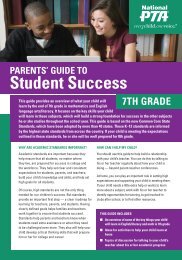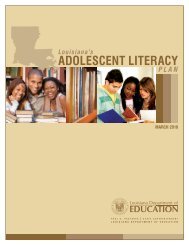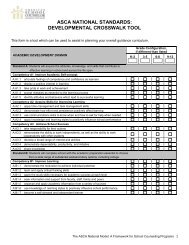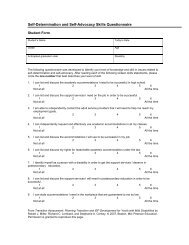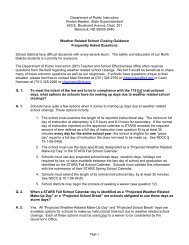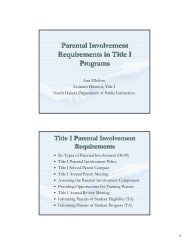Fifteen Effective Strategies for Improving Student Attendance
Fifteen Effective Strategies for Improving Student Attendance
Fifteen Effective Strategies for Improving Student Attendance
You also want an ePaper? Increase the reach of your titles
YUMPU automatically turns print PDFs into web optimized ePapers that Google loves.
Web Sites<br />
• High Schools That Work (HSTW) was established in 1987. The<br />
HSTW goals, key practices and key conditions are a framework<br />
<strong>for</strong> whole-school improvement at more than 1,100 high school<br />
sites in 26 states. http://www.sreb.org/programs/hstw/<br />
hstwindex.asp<br />
• The Center <strong>for</strong> Comprehensive School Re<strong>for</strong>m and Improvement<br />
collects and disseminates in<strong>for</strong>mation that builds the capacity<br />
of schools to raise the academic achievement of all students.<br />
http://www.csrclearinghouse.org/<br />
• New American Schools (NAS) is a nonpartisan, nonprofit organization<br />
whose mission is to increase student achievement<br />
through comprehensive school improvement strategies. http://<br />
www.naschools.org/<br />
School-Community Collaboration<br />
General Definition<br />
When all groups in a community provide collective support to<br />
the school, a strong infrastructure sustains a caring environment<br />
where youth can thrive and achieve.<br />
“Truancy is costly. . . . It costs businesses, which must pay to<br />
train uneducated workers. It costs taxpayers, who must pay higher<br />
taxes <strong>for</strong> law en<strong>for</strong>cement, and welfare costs <strong>for</strong> dropouts who end<br />
up on welfare rolls or underemployed” (Garry, 1996, p. 2).<br />
Successful ef<strong>for</strong>ts to improve attendance view truancy as more<br />
than just a “school” issue and involve the entire community (Gullatt,<br />
& Lemoine, 1997).<br />
Publications<br />
Garry, E. M. (1996, October). Truancy: First step to a lifetime of<br />
problems. Juvenile Justice Bulletin. Washington, DC: Office of Juvenile<br />
Justice and Delinquency Prevention.<br />
Gullatt, D. E., & Lemoine, D. A. (1997). Assistance <strong>for</strong> the school<br />
administrator concerned about student truancy. (ERIC Document<br />
Reproduction Service No. ED409653)<br />
Henderson, A. T., & Mapp, K. L. (2002). A new wave of evidence: The<br />
impact of school, family, and community connections on student<br />
achievement [Annual synthesis]. Austin, TX: Southwest Educational<br />
Development Laboratory, National Center <strong>for</strong> Family &<br />
Community Connections with Schools.<br />
Jordon, C., Orozco, E., & Averett, A. (2002). Emerging Issues in School,<br />
Family, & Community Connections. Austin, TX: Southwest Educational<br />
Development Laboratory, National Center <strong>for</strong> Family &<br />
Community Connection With Schools.<br />
Model Programs<br />
Project Respect (PR) began in January of 2000 with 15 caseworkers<br />
known as “Community Advocates.” Each Advocate serves<br />
10 to 12 families at a time. The Advocates make phone calls or<br />
visits to the home of every child in the school who has a specified<br />
number of absences to prevent a pattern of truancy developing.<br />
<strong>Student</strong>s in the program cut their absences by 50%. All the high<br />
school students improved their standardized state test scores. Sixtyone<br />
percent of the students with identified behavior concerns im-<br />
6<br />
proved their behavior, as evidenced by reduced suspensions and<br />
office referrals. Grades improved <strong>for</strong> 139 (41%) of PR students by<br />
an average of 12% in reading, 9% in math, and 12% in language<br />
arts. These figures translate into over one letter grade improvement<br />
<strong>for</strong> most students. <strong>Attendance</strong> improved <strong>for</strong> 77% of PR students,<br />
and there was a 75% rate of success. Contact: Terri Martinez-<br />
McGraw; Public School District 60; Pueblo, CO 81003; telephone:<br />
719-549-7380; http://www.pueblo60.k12.co.us<br />
King County Superior Court At-Risk Youth Program uses multiple<br />
approaches along the truancy continuum to best respond to<br />
truant youth and their families. Community-based attendance workshops<br />
allow youth with few unexcused absences and no other major<br />
concerns to avoid <strong>for</strong>mal court by creating an attendance contract.<br />
Community truancy boards allow youth and families a facilitated<br />
way to create an agreement with the school district to improve<br />
school attendance. Formal court and short-term case management<br />
provide a legal <strong>for</strong>um to resolve truancy and other issues<br />
<strong>for</strong> youth with multiple absences or concerns. The program provides<br />
technical assistance to schools and other agencies responding<br />
to youth in trouble. In the first year of the workshops, preliminary<br />
hearings were reduced by 57%. In addition, 75% of the youth<br />
that attended did not go on to court on the truancy matter. Contact:<br />
Jan Solomon, Suzie Carolan, or Wayne Dallas; King County Superior<br />
Court; 1401 East Jefferson Street, Suite 506; Seattle, WA 98122;<br />
telephone: 206-296-9335 http://www.metrokc.gov<br />
Jacksonville United Against Truancy (JUAT) is a collaborative ef<strong>for</strong>t<br />
initially spearheaded by the State Attorney’s Office in Jacksonville,<br />
Florida, as part of their truancy reduction activities. Some of the members<br />
of the collaborative are Duval County Public Schools, the City of<br />
Jacksonville, the Jacksonville Sheriff’s Office, the Youth Crisis Center,<br />
Florida Department of Juvenile Justice, Office of Juvenile Justice and<br />
Delinquency Prevention, Jacksonville Housing Authority, Lutheran Social<br />
Services and St. Paul’s Community Empowerment Center. Their<br />
main goal is public awareness about the truancy issue. They have developed<br />
brochures in four languages that define truancy and provide<br />
families with in<strong>for</strong>mation on how to get help. They have established<br />
September as Truancy Awareness Month in Jacksonville. Corporate<br />
sponsors include Burger King and BellSouth. Contact: Jacksonville United<br />
Against Truancy; State Attorney’s Office Fourth Judicial Circuit of Florida;<br />
330 East Bay Street; Jacksonville, FL 32202; telephone: 904-630-2169;<br />
email: sao4th@coj.net http://www.coj.net/Departments/State<br />
Attorneys+Office+/Jacksonville+United+Against+Truancy/<br />
default.htm<br />
Web Sites<br />
• America’s Promise has as its mission to mobilize people from<br />
every sector of American life to build the character and competence<br />
of our nation’s youth by fulfilling Five Promises <strong>for</strong> young<br />
people. http://www.americaspromise.org/<br />
• Communities In Schools is the nation’s leading community-based<br />
organization helping kids succeed in school and prepare <strong>for</strong> life.<br />
http://www.cisnet.org/<br />
• Public Education Network (PEN) has as its mission to create systems<br />
of public education that result in high achievement <strong>for</strong> every<br />
child. PEN is a national association of local education funds<br />
(LEFs) advancing school re<strong>for</strong>m in low-income communities<br />
across the country. http://www.publiceducation.org/<br />
Research Report





